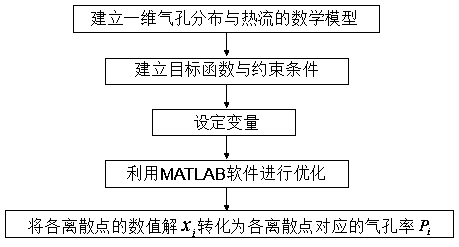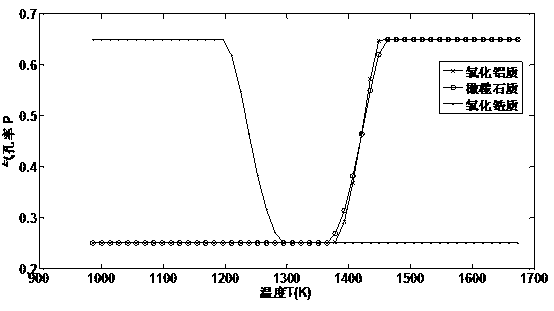An Optimal Control Method for Thermal Insulation Performance of Porous Materials
A porous material, optimized control technology, applied in the field of porous materials, can solve the problems of no pore control method, inapplicability, etc., and achieve the effects of improved thermal insulation performance, strong applicability, and reliable results
- Summary
- Abstract
- Description
- Claims
- Application Information
AI Technical Summary
Problems solved by technology
Method used
Image
Examples
Embodiment 1
[0065] A kind of mullite Al 6 Si 2 o 13 Optimal control method for thermal insulation performance of porous materials. The optimal control method described in this embodiment is as follows: figure 1 Shown:
[0066] Step 1. Establish a mathematical model of one-dimensional porosity distribution and heat flow
[0067] Let the temperature follow the mullite Al 6 Si 2 o 13 The heat transfer direction of the porous material is linearly distributed, and the mullite Al 6 Si 2 o 13 Thermal conductivity K of porous materials as a function of heat transfer direction, mullite Al 6 Si 2 o 13 The mathematical model f of the one-dimensional porosity distribution and heat flow q of porous materials is
[0068]
[0069] In formula (1):
[0070] n represents mullite Al 6 Si 2 o 13 The total number of discrete points set in the heat transfer direction of the porous material, n=100;
[0071] i means mullite Al 6 Si 2 o 13 The serial number of the discrete point set in the...
Embodiment 2
[0119] An optimal control method for the thermal insulation performance of porous materials with different solid phase matrices. The optimal control method described in this embodiment is as follows: figure 1 Shown:
[0120] Step 1. Establish a mathematical model of one-dimensional porosity distribution and heat flow
[0121] Assuming that the temperature is linearly distributed along the heat transfer direction of different solid matrix porous materials, the thermal conductivity K of different solid matrix porous materials is a function of the heat transfer direction, and the mathematical relationship between the one-dimensional porosity distribution and heat flow q of different solid matrix porous materials Model f is
[0122]
[0123] In formula (1):
[0124] n represents the total number of discrete points set in the direction of heat transfer for different solid matrix porous materials, n=50;
[0125] i represents the serial number of discrete points set in the dir...
Embodiment 3
[0175] A method for optimizing and controlling the thermal insulation performance of alumina porous materials. The optimal control method described in this embodiment is as follows: figure 1 Shown:
[0176] Step 1. Establish a mathematical model of one-dimensional porosity distribution and heat flow
[0177] Assuming that the temperature is linearly distributed along the heat transfer direction of the alumina porous material, the thermal conductivity K of the alumina porous material is a function of the heat transfer direction, and the mathematical model f of the one-dimensional porosity distribution and heat flow q of the alumina porous material is
[0178]
[0179] In formula (1):
[0180] n represents the total number of discrete points set in the heat transfer direction of the alumina porous material, n=60;
[0181] i represents the serial number of the discrete point set in the heat transfer direction of the alumina porous material;
[0182] x i Represents the rel...
PUM
 Login to View More
Login to View More Abstract
Description
Claims
Application Information
 Login to View More
Login to View More - Generate Ideas
- Intellectual Property
- Life Sciences
- Materials
- Tech Scout
- Unparalleled Data Quality
- Higher Quality Content
- 60% Fewer Hallucinations
Browse by: Latest US Patents, China's latest patents, Technical Efficacy Thesaurus, Application Domain, Technology Topic, Popular Technical Reports.
© 2025 PatSnap. All rights reserved.Legal|Privacy policy|Modern Slavery Act Transparency Statement|Sitemap|About US| Contact US: help@patsnap.com



